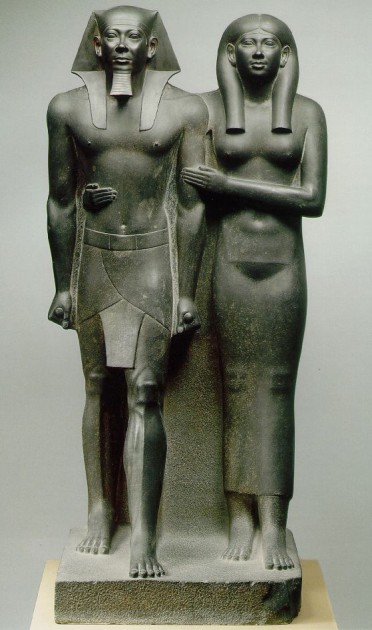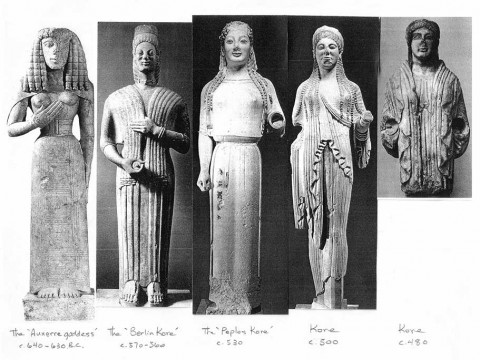what is the literal translation of the term used to denote a sculptor in egyptian writing?

Metropolitan Kouros, c. 590-580 BC. Metropolitan Museum of Art
Last fall, when I taught about the Primitive Menstruation in ancient Greece, a student pointed out that many of the kouroi figures were standing with their left foot forward. Nosotros discussed how Egyptian figures often are striding forrard with their left foot too, and peradventure the Greeks just adopted this composition due to compositional balance. But my student pressed, "But why the left foot? Was the left foot itself of import for some blazon of reason?"

Menkaure and Queen (perchance his wife Khamerernebty Two), 2490-2472 BCE. Graywacke with traces of carmine and blackness paint, height 54.v″ (142.3 cm). Museum of Fine Arts, Boston
I have puzzled over this student'south question for several months, peculiarly as to whether there is significance with the advancing left foot in Egyptian civilization, and whether that same type of significance would have carried into Greek culture. We tin can run across that a large number of Egyptian statues, including male and female figures, adopted the "left human foot forward" stance; Menkaure and his Queen (shown above), the colossal statue of Queen Tuya (Vatican Museum), Karomama (Louvre), and wooden tomb statue of Tjeti (British Museum) are just a few of the many examples that exist. Some sources debate that Egyptian females are typically represented with both feet together, simply I am increasingly wary of that generalization.ane
Did the left foot hold special significance for the Egyptians, since this convention appears throughout ancient Egyptian history? I oasis't come to a conclusive answer by whatever means, but I have come across a few ideas. One idea was presented to me through Twitter: Ma Magdalena Ziegler (@ZiZiChan) wrote to me that for the Egyptians, the "left side is where the heart resides & information technology's the house of volition, emotions & consciousness, the heart of life itself." A similar idea was presented in an online forum on Arab republic of egypt, where writer Al Waze-look King wrote, "The real meaning behind the position of the statue [with the advancing left leg] is esoteric. The left side of your body is where the heart is. The Egyptians believed you lot stepped with the left foot to trod out evil and then the heart could go along." Some other online forum (which actually is dedicated to Freemasons) claims that the left foot is represent the power of Isis, a fertility goddess who is associated with life and new beginnings. Some other possibility shared by a tour guide in Arab republic of egypt is that the left foot forward could suggest that the figure represented in the work of fine art had been involved in the armed services.ii
Autonomously from these online exchanges, I haven't come across any published scholarship to support these ideas, let lonely any directly historical document that connects this idea to Egyptian sculpture itself. (If anyone knows of scholarship that supports these ideas or presents an alternative view, delight let me know!) Regardless, though, I do call up that the question of the left foot needs to exist taken further when it comes to Egyptian influence on archaic Greek sculpture. The connection between Egyptian sculpture and aboriginal kouroi/korai has long been established past scholars. 3 Scholars fifty-fifty argue that some kouroi (specifically the Metropolitan Kouros, shown at the meridian of this mail) was based off of the Egyptian canon of proportions. 4

Kouroi examples, culminating with the Kritios Boy from the Early Classical period. Note that the "Piraeus Apollo" is a "transitional sculpture" that is dissimilar from the others, since his right human foot advancing.
But did the ancient Greeks adopt the "left foot forward" stance for similar reasons as the Egyptians, if Egyptians had symbolic reasoning in the beginning place? Unsurprisingly, I suppose, I haven't found a conclusive answer either. If anything, the bear witness that I found is contradictory to my Egyptian ideas and a niggling scrap too belatedly historically to coincide with many of the archaic kouroi: Aristotle (writing in the Late Classical period), wrote that the right side of the torso was the naturally stronger and more active than the left! 5
Archaeologist and art historian Gisela Richter, who published technical analyses on the kouroi and korai, notes the tradition of the advancing left foot in several types of kouroi and korai. half dozen However, Richter is quite silent as to the reasoning of compositional stance, only suggest that an evolving interest in naturalism and the creative person'due south want to suggest "the asymmetry of the two sides of the figure" led to the forward placement of the left leg. 7
The Euthydikos Kore, c. 480 BC. Acropolis Museum, Athens. Paradigm via Wikipedia, courtesy of Dorieo
When I started to write this postal service, I hoped to come with specific ideas and reasons behind the leg positions of the kouroi and korai. Instead, I hope this mail volition serve more as a forum and generator of ideas as to the stances of these statues. If you have whatsoever ideas every bit to why left leg was positioned every bit advancing in either Egyptian or Greek sculpture, please share!

Korai examples, ranging from c. 640 BCE to c. 480 BCE. Several of these korai have their anxiety placed shut together. The exception is the c. 500 BCE kore, who has an advancing left leg
I likewise may also never find a reason every bit to why some korai are depicted with their legs together (see above). Is there an "active male" vs. "passive female person" being expressed through some of these works of fine art? I'd dear to learn what others call up on this topic, too.
1 For example, more "left pes forward" female person statues tin can be seen in Gisela Thou. A. Richter, Korai: Primitive Greek Maidens (London: Phaidon, 1968), Plate I.
two Tom Cheshire, A Tourist in the Arab Spring (Bradt Travel Guides , 2013), p, 180.
iii Ibid., p. iv. Run across also Gisela M. A. Richter, Kouroi: Archaic Greek Youths: A Study of the Evolution of the Kouros Type in Greek Sculpture (London: Phaidon, 1960), p. 2.
4 For some discussion on the Metropolitan Kouros, see http://academic.reed.edu/humanities/110tech/kouroi2.html. For a more comprehensive analysis of kouroi proportions, see Eleanor Guralnick, "The Proportions of Kouroi" in The American Journal of Archæology 82, no. 4 (1978): 461-472. Commodity available online here: http://world wide web.jstor.org/discover/x.2307/504635?uid=2129&uid=ii&uid=seventy&uid=4&sid=21104058982547
v Geoffrey Earnest Richard Lloyd, Methods and Problems in Greek Science: Selected Papers (Cambridge: Academy of Cambridge Press, 1991), p. 44. Source available online here: http://books.google.com/books?id=zCg4AAAAIAAJ&lpg=PA43&ots=BnHcQOB55o&dq=greek%20left%20side%20of%20body&pg=PA44#v=onepage&q&f=false
vi Come across Richter, Korai: Primitive Greek Maidens, p. 4. Come across also Richter, Kouroi: Archaic Greek Youths, p. 25. Information technology should also be noted that several Greek korai are depicted with their anxiety together.
seven Richter, Kouroi: Archaic Greek Youths, p. 2-five, 21.
Source: http://albertis-window.com/2014/05/ancient-egyptians-and-greeks-left-foot-forward/
0 Response to "what is the literal translation of the term used to denote a sculptor in egyptian writing?"
Post a Comment